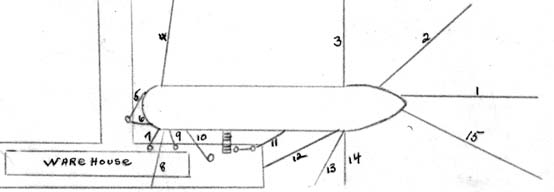|
Subject: Beaching of the S.S. NORTHWESTERN (continued)
- - - - - - - - - - - - - - - - - - - - - - - - - - - - - - - - - - - - -
8. During the day an attempt was made to take in the slack in the after mooring cable (#4). This cable was secured to the capstan in the anchor windlass room aft. A surge caught the line when taut and pulled the capstan out by the roots in a manner similar to that of extracting a tooth.
9. Due to a reported possible shifting of the wind direction to the northwest and to the concrete evidence that the ship's structure could not stand up under the strains of being secured to the beach the undersigned decided to abandon ship. It was felt that the best plan would be to have the maximum number of personnel off the ship and thus avoid a possible last minute attempt to abandon ship in case the ship did start to break up. A line was worked to the beach and there handled by a group of Siems Drake Puget Sound contractor party under charge of Mr. Leonard Clark, the General Superintendent. This line was secured to the power drum of a bull-dozer on the beach and through a sheave on the ship. One of the life boats of the S.S. Northwestern was secured to this line. The running end on the ship was handled by man power.
10. This rigging was completed by 3:40 p.m. and the first boat load of 22 Marines (truck and tractor drivers, searchlight operators, cooks, etc) and one commissioned officer was ferried ashore. The last boat load was completed at 6:50 p.m. After dark, about 4:20 p.m., illumination was furnished by truck lights, one of the anti-aircraft searchlights and a flood light rigged on the beach. In this manner 129 persons with a few personal articles and clothing each were transferred ashore. Six civilians, the mate, purser and four engineers, volunteered to remain aboard so as to maintain the cold storage plant. As it was felt that the ship was in no immediate danger these men were permitted to remain. However, a watch was established on the beach so that an immediate rescue could be effected in case of necessity.
11. The transfer ashore was greatly assisted by the use of two SCR-195 radio sets, one on the ship and one on the beach. By means of these voice radios, the signals for handling the lines were executed in a quiet manner. The entire transfer was completed with such ease that it reminded me of the handling of ships through the Panama Canal.
12. The personnel moved ashore were quartered la the 95% completed marine barracks.
13. Work of removing food, personal effects, and other property, in order named, was resumed Sunday morning. Due to another threatened shift of the wind to the northwest, this work was continued until 11:30 p.m., at which time all personal effects and about three weeks of food supply had been transferred ashore. The transfer of the food supply was considered imperative as no local food supply was available. The manager of the Northern Commercial Company informed me that with the additional 135 persons from the S.S. NORTHWESTERN there would be only food enough to last for ten days. This shortage of food in Unalaska was due to the non-arrival of the S.S. CORDOVA.
- 3 -
|
